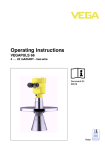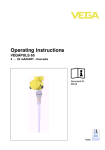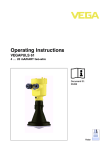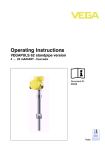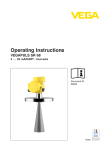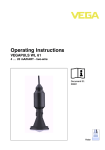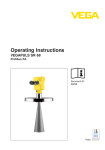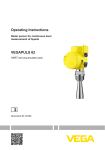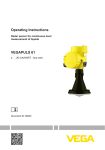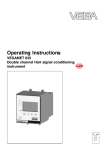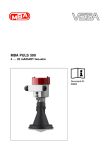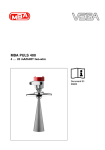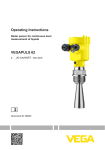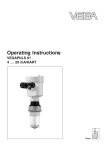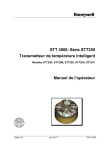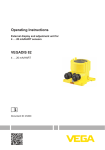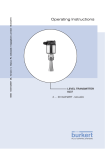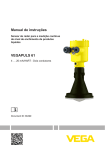Download Operating Instructions - VEGAPULS 61 - 4 ? 20 mA/HART
Transcript
Operating Instructions VEGAPULS 61 4 … 20 mA/HART - two-wire Document ID: 36499 Radar Contents Contents 1 About this document 1.1 1.2 1.3 2 . . . . . . . . . . . . . . . . . . . . . . . . . . . . . . . . . . . . . . . . . . . . . . . . . . . . . . . . . . . . . . . . . . . . . . . . .. .. .. .. .. .. .. .. .. 5 5 5 5 6 6 6 6 7 Structure . . . . . . . . . . . . . . . . . . . . Principle of operation . . . . . . . . . . . Packaging, transport and storage . . Accessories and replacement parts . . . . . . . . . . . . . . . . . . . . . . . . . . . . . . . . . . . . . . . . . . . . . .. .. .. .. 8 9 10 10 General instructions . . . . . . . . . . . . . . Collar or adapter flange . . . . . . . . . . . Mounting preparations, mounting strap. Instructions for installation . . . . . . . . . . . . . . . . . . . . . . . . . . . . . . . . . . . . . . . . . . . . . . .. .. .. .. 12 12 13 14 Preparing the connection . . . . . . . . . . . . . . . . Connect . . . . . . . . . . . . . . . . . . . . . . . . . . . . . Wiring plan, single chamber housing . . . . . . . . Wiring plan, double chamber housing . . . . . . . Wiring plan with double chamber housing Ex d Wiring plan - version IP 66/IP 68, 1 bar . . . . . . Switch-on phase. . . . . . . . . . . . . . . . . . . . . . . . . . . . . . . . . . . . . . . . . . . . .. .. .. .. .. .. .. 27 28 29 30 31 33 33 . . . . . . . . . . . . .. .. .. .. 34 36 37 50 Connect the PC . . . . . . . . . . . . . . . . . . . . . . . . . . . . Parameter adjustment with PACTware . . . . . . . . . . . . Saving the parameter adjustment data . . . . . . . . . . . . 52 53 54 Insert indicating and adjustment module. Adjustment system . . . . . . . . . . . . . . . . Parameter adjustment. . . . . . . . . . . . . . Saving the parameter adjustment data . . . . . . . . . . . . . . . . . . . . . . Setup with PACTware VEGAPULS 61 • 4 … 20 mA/HART - two-wire 36499-EN-120301 7.1 7.2 7.3 2 . . . . . . . . . . . . . . . . . . Set up with the indicating and adjustment module 6.1 6.2 6.3 6.4 7 . . . . . . . . . . . . . . . . . . Connecting to power supply 5.1 5.2 5.3 5.4 5.5 5.6 5.7 6 . . . . . . . . . . . . . . . . . . Mounting 4.1 4.2 4.3 4.4 5 . . . . . . . . . Authorised personnel . . . . . . . Appropriate use . . . . . . . . . . . Warning about misuse . . . . . . General safety instructions . . . CE conformity . . . . . . . . . . . . NAMUR recommendations . . . Radio license for Europe. . . . . Radio license for USA/Canada Environmental instructions. . . . Product description 3.1 3.2 3.3 3.4 4 4 4 4 For your safety 2.1 2.2 2.3 2.4 2.5 2.6 2.7 2.8 2.9 3 Function. . . . . . . . . . . . . . . . . . . . . . . . . . . . . . . . . . Target group . . . . . . . . . . . . . . . . . . . . . . . . . . . . . . Symbolism used. . . . . . . . . . . . . . . . . . . . . . . . . . . . Contents 8 Set up with other systems 8.1 8.2 9 DD adjustment programs . . . . . . . . . . . . . . . . . . . . . Communicator 375, 475 . . . . . . . . . . . . . . . . . . . . . . 55 55 Diagnosis, Asset Management and service .. .. .. .. .. .. .. 56 56 57 61 65 66 67 10.1 Dismounting steps . . . . . . . . . . . . . . . . . . . . . . . . . . 10.2 Disposal . . . . . . . . . . . . . . . . . . . . . . . . . . . . . . . . . 68 68 9.1 9.2 9.3 9.4 9.5 9.6 9.7 Maintaining . . . . . . . . . . . . . . . . . . Measured value and event memory . Asset Management function . . . . . . Remove interferences . . . . . . . . . . . Exchanging the electronics module . Software update . . . . . . . . . . . . . . . How to proceed in case of repair. . . . . . . . . . . . . . . . . . . . . . . . . . . . . . . . . . . . . . . . . . . . . . . . . . . . . . . . . . . . . . . . . . . . . . . . . . . . . . . . 10 Dismounting 11 Supplement 11.1 Technical data . . . . . . . . . . . . . . . . . . . . . . . . . . . . . 11.2 Dimensions . . . . . . . . . . . . . . . . . . . . . . . . . . . . . . . 69 78 36499-EN-120301 Safety instructions for Ex areas Please note the Ex-specific safety information for installation and operation in Ex areas. These safety instructions are part of the operating instructions manual and come with the Ex-approved instruments. Editing status: 2012-02-08 VEGAPULS 61 • 4 … 20 mA/HART - two-wire 3 1 About this document 1 About this document 1.1 Function This operating instructions manual provides all the information you need for mounting, connection and setup as well as important instructions for maintenance and fault rectification. Please read this information before putting the instrument into operation and keep this manual accessible in the immediate vicinity of the device. 1.2 Target group This operating instructions manual is directed to trained qualified personnel. The contents of this manual should be made available to these personnel and put into practice by them. 1.3 Symbolism used Information, tip, note This symbol indicates helpful additional information. Caution: If this warning is ignored, faults or malfunctions can result. Warning: If this warning is ignored, injury to persons and/or serious damage to the instrument can result. Danger: If this warning is ignored, serious injury to persons and/or destruction of the instrument can result. Ex applications This symbol indicates special instructions for Ex applications. l à 1 List The dot set in front indicates a list with no implied sequence. Action This arrow indicates a single action. Sequence Numbers set in front indicate successive steps in a procedure. 36499-EN-120301 4 VEGAPULS 61 • 4 … 20 mA/HART - two-wire 2 For your safety 2 For your safety 2.1 Authorised personnel All operations described in this operating instructions manual must be carried out only by trained specialist personnel authorised by the plant operator. During work on and with the device the required personal protective equipment must always be worn. 2.2 Appropriate use VEGAPULS 61 is a sensor for continuous level measurement. You can find detailed information on the application range in chapter "Product description". Operational reliability is ensured only if the instrument is properly used according to the specifications in the operating instructions manual as well as possible supplementary instructions. 2.3 Warning about misuse Inappropriate or incorrect use of the instrument can give rise to application-specific hazards, e.g. vessel overfill or damage to system components through incorrect mounting or adjustment. 2.4 General safety instructions This is a state-of-the-art instrument complying with all prevailing regulations and guidelines. The instrument must only be operated in a technically flawless and reliable condition. The operator is responsible for the trouble-free operation of the instrument. During the entire duration of use, the user is obliged to determine the compliance of the necessary occupational safety measures with the current valid rules and regulations and also take note of new regulations. The safety instructions in this operating instructions manual, the national installation standards as well as the valid safety regulations and accident prevention rules must be observed by the user. 36499-EN-120301 For safety and warranty reasons, any invasive work on the device beyond that described in the operating instructions manual may be carried out only by personnel authorised by the manufacturer. Arbitrary conversions or modifications are explicitly forbidden. The safety approval markings and safety tips on the device must also be observed. VEGAPULS 61 • 4 … 20 mA/HART - two-wire 5 2 For your safety Depending on the instrument version, the emitting frequencies are in the C or K band range. The low emitting frequencies are far below the internationally approved limit values. When used correctly, there is no danger to health. 2.5 CE conformity The device fulfills the legal requirements of the applicable EC guidelines. With the CE mark, we provide confirmation of successful testing. You can find the conformity certificate in the download section of our homepage. Only with Ex-d-ia version The instrument is designed for use in an industrial environment. Nevertheless, electromagnetic interference from electrical conductors and radiated emissions must be taken into account, as is usual with a class A instrument according to EN 61326-1. If the instrument is used in a different environment, its electromagnetic compatibility with other devices must be ensured by suitable measures. 2.6 NAMUR recommendations NAMUR is a user association for automation technology in the process industries in Germany. The published NAMUR recommendations are accepted as the standard in field instrumentation. The device fulfills the requirements of the following NAMUR recommendations: l l l l NE 21 – Electromagnetic compatibility of equipment NE 43 – Standardization of the signal level for malfunction information from digital transmitters NE 53 – Compatibility of field devices and indicating/adjustment components NE 107 - Self-monitoring and diagnosis of field devices For further information see www.namur.de. 2.7 Radio license for Europe The instrument is approved according to EN 302372-1/2 (2006-04) for use in closed vessels. 2.8 Radio license for USA/Canada l 6 The device must not generate interfering emissions, and VEGAPULS 61 • 4 … 20 mA/HART - two-wire 36499-EN-120301 The instrument is in conformity with part 15 of the FCC regulations. Take note of the following two regulations: 2 For your safety l The device must be non-sensitive to interfering immissions, including those that may cause undesirable operating conditions. Modifications not expressly approved by the manufacturer will lead to expiry of the operating licence according to FCC/IC. The instrument is in conformity with RSS-210 of the IC regulations. The instrument may only be operated in closed vessels made of metal, concrete, or fibre-reinforced plastic. 2.9 Environmental instructions Protection of the environment is one of our most important duties. That is why we have introduced an environment management system with the goal of continuously improving company environmental protection. The environment management system is certified according to DIN EN ISO 14001. Please help us fulfil this obligation by observing the environmental instructions in this manual: Chapter "Packaging, transport and storage" Chapter "Disposal" 36499-EN-120301 l l VEGAPULS 61 • 4 … 20 mA/HART - two-wire 7 3 Product description 3 Product description 3.1 Structure Type label The type label contains the most important data for identification and use of the instrument: 1 16 15 2 3 4 5 6 7 8 9 14 10 11 13 12 Fig. 1: Structure of the type label (example) 1 2 3 4 5 6 7 8 9 10 11 12 13 14 15 16 Serial number Instrument type Product code Approvals Power supply and signal output, electronics Protection rating Measuring range Process and ambient temperature, process pressure Material, wetted parts Hardware and software version Order number Serial number of the instrument Symbol of the device protection class ID numbers, instrument documentation Note to observe the instrument documentation Notified authority for CE marking Approval directive With the serial number of the instrument on the type label you have access to the following data on our homepage: l l l l l l Article number of the instrument (HTML) Delivery date (HTML) Order-specific instrument features (HTML) Operating instructions at the time of shipment (PDF) Order-specific sensor data for an electronics exchange (XML) Test certificate "Measuring Accuracy" (PDF) 8 VEGAPULS 61 • 4 … 20 mA/HART - two-wire 36499-EN-120301 Go to www.vega.com, "Service" "VEGA Tools" and "serial number search". 3 Product description Scope of the operating instructions manual This operating instructions manual applies to the following instrument versions: l l Versions The instrument is available in two different electronics versions. Each version can be identified via the product code on the type label as well as on the electronics. l l Scope of delivery Hardware from 2.1.1 Software from 4.4.0 Standard electronics type PS60HK.Electronics with increased sensitivity type PS60HS.- The scope of delivery encompasses: l l l Radar sensor Mounting strap with fixing material (optional) Documentation - this operating instructions manual - Test certificate measuring accuracy (optional) - Operating instructions manual "Indicating and adjustment module" (optional) - Supplementary instructions "GSM/GPRS radio module" (optional) - Supplementary instructions manual "Heating for indicating and adjustment module" (optional) - Supplementary instructions manual "Plug connector for continuously measuring sensors" (optional) - Ex-specific "Safety instructions" (with Ex versions) - if necessary, further certificates 3.2 Principle of operation Application area The VEGAPULS 61 is a radar sensor for continuous level measurement of liquids under simple process conditions. Dependent on the application range, different versions are used: l l l l Level measurement of aggressive liquids in small vessels: encapsulated antenna system Flow measurement in open flumes or gauge measurement of bodies of water: Plastic horn antenna Products with an εr value ≥1.8: Standard electronics Products with an εr value ≥1.5, < 1.8; applications with very poor reflective properties: Electronics with increased sensitivity The actual values that can be reached depend on the measurement conditions, the antenna system or the standpipe or bypass. 36499-EN-120301 Functional principle The antenna of the radar sensor emits short radar pulses with a duration of approx. 1 ns. These pulses are reflected by the product and received by the antenna as echoes. The running time of the radar pulses from emission to reception is proportional to the distance and hence to the level. The determined level is converted into an appropriate output signal and outputted as measured value. VEGAPULS 61 • 4 … 20 mA/HART - two-wire 9 3 Product description 3.3 Packaging, transport and storage Packaging Your instrument was protected by packaging during transport. Its capacity to handle normal loads during transport is assured by a test according to DIN EN 24180. The packaging of standard instruments consists of environmentfriendly, recyclable cardboard. For special versions, PE foam or PE foil is also used. Dispose of the packaging material via specialised recycling companies. Transport Transport must be carried out under consideration of the notes on the transport packaging. Nonobservance of these instructions can cause damage to the device. Transport inspection The delivery must be checked for completeness and possible transit damage immediately at receipt. Ascertained transit damage or concealed defects must be appropriately dealt with. Storage Up to the time of installation, the packages must be left closed and stored according to the orientation and storage markings on the outside. Unless otherwise indicated, the packages must be stored only under the following conditions: Storage and transport temperature l l l l l Not in the open Dry and dust free Not exposed to corrosive media Protected against solar radiation Avoiding mechanical shock and vibration l Storage and transport temperature see chapter "Supplement Technical data - Ambient conditions" Relative humidity 20 … 85 % l 3.4 Accessories and replacement parts Indicating and adjustment module The indicating and adjustment module PLICSCOM is used for measured value indication, adjustment and diagnosis. It can be inserted into the sensor and removed at any time. You can find further information in the operating instructions "Indicating and adjustment module PLICSCOM" (Document-ID 27835). Interface adapter You can find further information in the operating instructions "Interface adapter VEGACONNECT" (Document-ID 32628). 10 VEGAPULS 61 • 4 … 20 mA/HART - two-wire 36499-EN-120301 The interface adapter VEGACONNECT enables the connection of communication-capable instruments to the USB interface of a PC. For parameter adjustment of these instruments, an adjustment software such as PACTware with VEGA-DTM is required. 3 Product description External indicating and adjustment unit VEGADIS 61 is an external indicating and adjustment unit for sensors with single chamber housing and Ex-d double chamber housing. It is suitable for measured value indication and adjustment of plics® sensors and is connected to the sensor with a four-wire, screened standard cable up to 50 m long. You can find further information in the operating instructions "VEGADIS 61" (Document-ID 27720). External indicating and adjustment unit with HART protocol VEGADIS 62 is suitable for measured value indication and adjustment of sensors with HART protocol. It is looped into the 4 … 20 mA/HART signal cable. You can find further information in the operating instructions "VEGADIS 62" (Document-ID 36469). External radio unit The PLICSMOBILE T61 is an external GSM/GPRS radio unit for transmission of measured values and for remote parameter adjustment of plics® sensors. The adjustment is carried out via PACTware/ DTM by using the integrated USB connection. You can find further information in the supplementary instructions "PLICSMOBILE T61" (Document-ID 36849). Protective cap The protective cover protects the sensor housing against soiling and intense heat from solar radiation. You will find additional information in the supplementary instructions manual "Protective cover" (Document-ID 34296). Electronics module The electronics module VEGAPULS series 60 is a replacement part for radar sensors of VEGAPULS series 60. An own version is available for each type of signal output. 36499-EN-120301 You can find further information in the operating instructions "Electronics module VEGAPULS series 60" (Document-ID 36801). VEGAPULS 61 • 4 … 20 mA/HART - two-wire 11 4 Mounting 4 Mounting 4.1 General instructions Screwing in With instruments with threaded process fitting, suitable tools must be applied for tightening the hexagon. Warning: The housing must not be used to screw the instrument in! Applying tightening force can damage internal parts of the housing. Moisture Use the recommended cables (see chapter "Connecting to power supply") and tighten the cable gland. You can give your instrument additional protection against moisture penetration by leading the connection cable downward in front of the cable entry. Rain and condensation water can thus drain off. This applies mainly to outdoor mounting as well as installation in areas where high humidity is expected (e.g. through cleaning processes) or on cooled or heated vessels. Suitability for the process conditions Make sure that all parts of the instrument exposed to the process, in particular the active measuring component, process seal and process fitting, are suitable for the existing process conditions. These include above all the process pressure, process temperature as well as the chemical properties of the medium. You can find the specifications in chapter "Technical data" and on the type label. 4.2 Collar or adapter flange For mounting the instrument on a socket, a combi compression flange for DN 80 (ASME 3" or JIS 80) is also available for retro fitting. Optionally, the instrument can be also equipped with an adapter flange from DN 100 (ASME 4" or JIS 100). With the housing versions plastic, aluminium single chamber and stainless steel, the collar flange can be placed directly over the housing. With the aluminium double chamber housing, retroactive mounting in this way is not possible - the mounting type must be specified with the order. You can find drawings of these mounting options in chapter "Dimensions". 36499-EN-120301 12 VEGAPULS 61 • 4 … 20 mA/HART - two-wire 4 Mounting Fig. 2: Flange mounting of the radar sensor 4.3 Mounting preparations, mounting strap The mounting strap enables simple mounting on the vessel wall or silo top. It is suitable for wall, ceiling or boom mounting. Especially in open vessels this is a very easy and effective way to align the sensor to the bulk solid surface. The strap is supplied unassembled and must be screwed to the sensor before setup with three hexagon screws M5 x 10 and spring washers. Max. torque, see chapter "Technical data". Required tools: Allen wrench size 4. There are two ways to screw the strap onto the sensor. Depending on the selected version, the sensors can be swivelled in the strap as follows: Single chamber housing - Angle of inclination 180°, infinitely variable - Angle of inclination in three steps 0°, 90° and 180° l Double chamber housing - Angle of inclination 90°, infinitely variable - Angle of inclination in two steps 0° and 90° 36499-EN-120301 l VEGAPULS 61 • 4 … 20 mA/HART - two-wire 13 4 Mounting Fig. 3: Adjustment of the angle of inclination Fig. 4: Turning by fastening in the centre 4.4 Instructions for installation Tight installation of the plastic horn antenna Polarisation plane For tight installation of the version with plastic horn antenna with compression or adapter flange, the following conditions must be fulfilled: 1 Use suitable flat seal, e.g. of EPDM with Shore hardness 25 or 50 2 Make sure the number of flange screws corresponds to the number of flange holes 3 Tighten all screws with the torque stated in the technical data The emitted radar impulses of the radar sensor are electromagnetic waves. The polarisation plane is the direction of the electrical wave component. By turning the instrument in the connection flange or mounting boss, the polarisation can be used to reduce the effects of false echoes. The position of the polarisation plane is marked on the process fitting of the instrument. 36499-EN-120301 14 VEGAPULS 61 • 4 … 20 mA/HART - two-wire 4 Mounting 1 Fig. 5: Position of the polarisation plane with VEGAPULS 61 with encapsulated antenna system 1 Marking hole 1 Fig. 6: Position of the polarisation plane with VEGAPULS 61 with plastic horn antenna 1 Mounting position Marking bars When mounting the sensor, keep a distance of at least 200 mm (7.874 in) to the vessel wall. If the sensor is installed in the center of dished or round vessel tops, multiple echoes can arise. These can, however, be suppressed by an appropriate adjustment (see chapter "Setup"). 36499-EN-120301 If you cannot keep this distance you should carry out a false echo storage before setup. This applies mainly if buildup on the vessel wall is expected. In this case, we recommend repeating a false echo storage later with existing buildup. VEGAPULS 61 • 4 … 20 mA/HART - two-wire 15 4 Mounting > 200 mm (7.87") Fig. 7: Mounting of the radar sensor on round vessel tops In vessels with conical bottom it can be advantageous to mount the sensor in the center of the vessel, as measurement is then possible down to the lowest point of the vessel bottom. Fig. 8: Mounting of the radar sensor on vessels with conical bottom Inflowing medium Do not mount the instruments in or above the filling stream. Make sure that you detect the product surface, not the inflowing product. 36499-EN-120301 16 VEGAPULS 61 • 4 … 20 mA/HART - two-wire 4 Mounting Fig. 9: Mounting of the radar sensor with inflowing medium Socket with plastic horn antenna A corresponding collar flange for DN 80 (ASME 3" or JIS 80) as well as a suitable adapter flange are available for mounting VEGAPULS 61. With the housing versions plastic, aluminium single chamber and stainless steel, the collar flange can be placed directly over the housing. With the aluminium double chamber housing, retroactive mounting in this way is not possible - the mounting type must be specified with the order. 36499-EN-120301 Information: The socket should be as short as possible and the socket end should be rounded. Interfering reflections from the vessel socket are thus minimised. Fig. 10: Recommended socket mounting VEGAPULS 61 • 4 … 20 mA/HART - two-wire 17 4 Mounting h If the medium has good reflective properties, VEGAPULS 61 can also be mounted on a longer socket piece. Recommended values for socket heights are specified in the following illustration. You must carry out a false echo storage afterwards. d The below charts specify the max. socket piece length h depending on the diameter d. Socket diameter d Socket length h 80 mm 300 mm 100 mm 400 mm 150 mm 500 mm Socket diameter d 3" Socket length h 11.8 in 4" 15.8 in 6" 19.7 in Tip: In new facilities it is useful to incline the vessel socket in the direction of the outlet. False reflections from the vessel wall are thus reduced and measurement all the way down to the bottom of the conical outlet is possible. 36499-EN-120301 18 VEGAPULS 61 • 4 … 20 mA/HART - two-wire 4 Mounting Fig. 12: Alignment in silos The socket piece should be dimensioned in such a way that the antenna end protrudes at least 10 mm (0.4 in) out of the socket. ca. 10 mm Socket with encapsulated antenna system 36499-EN-120301 Fig. 13: Recommended socket mounting If the reflective properties of the medium are good, you can mount VEGAPULS 61 on sockets which are higher than the length of the antenna. You will find recommended values for socket heights in the following illustration. The socket end should be smooth and burr-free, if possible also rounded. After installation you must carry out a false echo storage. VEGAPULS 61 • 4 … 20 mA/HART - two-wire 19 h 4 Mounting d d 1½" 50 mm/2" 80 mm/3" 100 mm/4" 150 mm/6" h 200 mm 250 mm 300 mm 500 mm 800 mm Fig. 14: Deviating socket dimensions Sensor orientation Align the sensor in liquids as vertical as possible to the product surface to achieve optimum measurement results. Fig. 15: Alignment in liquids Vessel installations The mounting location of the radar sensor should be a place where no other equipment or fixtures cross the path of the microwave signals. Vessel installations, such as e.g. ladders, limit switches, heating spirals, struts, etc., can cause false echoes and impair the useful echo. Make sure when planning your measuring site that the radar sensor has a "clear view" to the measured product. In case of existing vessel installations, a false echo storage should be carried out during setup. 20 VEGAPULS 61 • 4 … 20 mA/HART - two-wire 36499-EN-120301 If large vessel installations such as struts or supports cause false echoes, these can be attenuated through supplementary measures. Small, inclined sheet metal baffles above the installations scatter the radar signals and prevent direct interfering reflections. 4 Mounting Fig. 16: Cover smooth profiles with deflectors Agitators If there are agitators in the vessel, a false signal memory should be carried out with the agitators in motion. This ensures that the interfering reflections from the agitators are saved with the blades in different positions. Fig. 17: Agitators Foam generation Through the action of filling, stirring and other processes in the vessel, compact foams that considerably damp the emitted signals may form on the product surface. 36499-EN-120301 If foams are causing measurement errors, the biggest possible radar antennas, the electronics with increased sensitivity or low frequency radar sensors (C band) should be used. As an alternative, sensors with guided microwave can be used. These are unaffected by foam generation and are best suited for such applications. VEGAPULS 61 • 4 … 20 mA/HART - two-wire 21 4 Mounting Measurement in a surge pipe When using a surge pipe in a vessel, influences from vessel installations and turbulences can be excluded. Under these prerequisites, the measurement of products with low dielectric values (εr value ≥ 1.6) is possible. In very adhesive products, measurement in a surge pipe is not recommended. 1 2 3 4 5 100% 6 7 8 9 0% Fig. 18: Configuration surge pipe 1 2 3 4 5 6 7 8 9 Radar sensor Marking of the polarisation direction Thread or flange on the instrument Vent hole Holes Weld joint Welding neck flange Ball valve with complete opening Fastening of the surge pipe Instructions for orientation: l Note marking of the polarisation plane on the sensor With threaded fitting, the marking is on the hexagon, with flange connection between the two flange holes All holes in the surge pipe must be in one plane with this marking Instructions for the measurement: 22 VEGAPULS 61 • 4 … 20 mA/HART - two-wire 36499-EN-120301 l l 4 Mounting l l l l l l The 100 % point must be below the upper vent hole and the antenna edge The 0 % point is the end of the surge pipe The tube diameter must be at least DN 40 or 1½" with antenna size 40 mm (1½") For the parameter adjustment, select "Application standpipe" and enter the tube diameter to compensate errors due to running time shift A false signal suppression with integrated sensor is recommended but not mandatory The measurement through a ball valve with complete run is possible Constructional requirements on the surge pipe: l l l l l l l l l l l An alternative to measurement in a surge pipe is measurement in a bypass tube outside of the vessel. 36499-EN-120301 Measurement in the bypass Material metal, smoother inner tube Preferably pultruded or straight beaded stainless steel tube Welded joint should be straight and lie in one axis with the holes Flanges are welded to the tube according to the orientation of the polarisation level In case of a extension with a welding neck flange or pipe collar as well as when a ball valve is used, the inner surfaces should be aligned and accurately joined together Gap size with junctions ≤ 0.1 mm Do not weld through the pipe wall. The surge pipe must remain smooth inside. Roughness and beads on the inside caused by unintentional penetration should be removed since they cause strong false echoes and encourage buildup Surge pipes must extend all the way down to the requested min. level, as measurement is only possible within the tube Diameter of holes ≤ 5 mm, any number OK, on one side or completely through The antenna diameter of the sensor should correspond to the inner diameter of the tube Diameter should be constant over the complete length VEGAPULS 61 • 4 … 20 mA/HART - two-wire 23 4 Mounting 1 2 3 4 100 % 6 5 0% Fig. 19: Configuration bypass 1 2 3 4 5 6 Radar sensor Marking of the polarisation direction Instrument flange Distance sensor reference plane to upper tube connection Distance of the tube connections Ball valve with complete opening Instructions for orientation: l l l Note marking of the polarisation plane on the sensor With threaded fitting, the marking is on the hexagon, with flange connection between the two flange holes The pipe connections to the vessel must be in one plane with this marking Instructions for the measurement: l l l l 24 VEGAPULS 61 • 4 … 20 mA/HART - two-wire 36499-EN-120301 l The 100 % point must not be above the upper tube connection to the vessel The 0 % point must not be below the lower tube connection to the vessel Min. distance sensor reference plane to the upper edge upper tube connection > 300 mm The tube diameter must be at least DN 40 or 1½" with antenna size 40 mm (1½") For the parameter adjustment, select "Application standpipe" and enter the tube diameter to compensate errors due to running time shift 4 Mounting l l A false signal suppression with integrated sensor is recommended but not mandatory The measurement through a ball valve with complete run is possible Constructional requirements on the bypass pipe: l l l l l l The short examples give you introductory information on the flow measurement. Detailed planning information is available from flume manufacturers and in special literature. 1 3 ... 4 hmax dmin Flow measurement with rectangular flume Material metal, smoother inner tube In case of an extremely rough tube inner surface, use an inserted tube (tube in tube) or a radar sensor with tube antenna Flanges are welded to the tube according to the orientation of the polarisation level Gap size with junctions ≤ 0.1 mm, for example, when using a ball valve or intermediate flanges with single pipe sections The antenna diameter of the sensor should correspond to the inner diameter of the tube Diameter should be constant over the complete length 2 3 ≥ 2 mm x hmax ≥ 50 mm 90° hmax 90° 4 Fig. 20: Flow measurement with rectangular flume: dmin. = min. distance of the sensor (see chapter "Technical data"); hmax. = max. filling of the rectangular flume 1 2 3 4 Overflow orifice (side view) Headwater Tail water Overfall orifice (view from bottom water) In general, the following points must be observed: 36499-EN-120301 l l l l l l Install the sensor on the headwater side Installation in the centre of the flume and vertical to the liquid surface Distance to the overfall orifice Distance of orifice opening above ground Min. distance of the orifice opening to bottom water Min. distance of the sensor to max. storage level VEGAPULS 61 • 4 … 20 mA/HART - two-wire 25 4 Mounting Flow measurement with Khafagi Venturi flume 3 ... 4 x hmax d 90° hmax 2 1 B Fig. 21: Flow measurement with Khafagi-Venturi flume: d = Min. distance to sensor; hmax. = max. filling of the flume; B = tightest constriction in the flume 1 2 Position sensor Venturi flume In general, the following points must be observed: l l l l Installation of the sensor at the inlet side Installation in the centre of the flume and vertical to the liquid surface Distance to the Venturi flume Min. distance of the sensor to max. storage level 36499-EN-120301 26 VEGAPULS 61 • 4 … 20 mA/HART - two-wire 5 Connecting to power supply 5 Connecting to power supply 5.1 Preparing the connection Safety instructions Always keep in mind the following safety instructions: l l Voltage supply Connect only in the complete absence of line voltage If voltage surges are expected, install overvoltage arresters Power supply and current signal are carried on the same two-wire cable. The voltage supply range can differ depending on the instrument version. The data for power supply are specified in chapter "Technical data". Provide a reliable separation between the supply circuit and the mains circuits according to DIN VDE 0106 part 101. Keep in mind the following additional factors that influence the operating voltage: l l Output voltage of the power supply unit can be lower under nominal load (with a sensor current of 20.5 mA or 22 mA in case of fault message) Influence of additional instruments in the circuit (see load values in chapter "Technical data") Connection to signal conditioning instruments The signal conditioning instruments VEGAMET and VEGASCAN have digital sensor recognition. When connecting VEGAPULS 61, an up-todate software version of the signal conditioning instrument is required. For a software update go to "Software" under "www.vega.com/ downloads". Connection cable The instrument is connected with standard two-wire cable without screen. If electromagnetic interference is expected which is above the test values of EN 61326-1 for industrial areas, screened cable should be used. For instruments with housing and cable gland, use cable with round cross-section. A cable outer diameter of 5 … 9 mm (0.2 … 0.35 in) ensures the seal effect of the cable gland. If you are using cable with a different diameter, exchange the seal or use a suitable cable gland. We generally recommend the use of screened cable for HART multidrop mode. 36499-EN-120301 Cable gland ½ NPT With plastic housing, the NPT cable gland or the Conduit steel tube must be screwed without grease into the threaded insert. Max. torque for all housings see chapter "Technical data" VEGAPULS 61 • 4 … 20 mA/HART - two-wire 27 5 Connecting to power supply Cable screening and grounding If screened cable is necessary, connect the cable screen on both ends to ground potential. In the sensor, the screen must be connected directly to the internal ground terminal. The ground terminal on the outside of the housing must be connected to the potential equalisation (low impedance). If potential equalisation currents are expected, the connection on the processing side must be made via a ceramic capacitor (e. g. 1 nF, 1500 V). The low frequency potential equalisation currents are thus suppressed, but the protective effect against high frequency interference signals remains. 5.2 Connect Connection technology The voltage supply and signal output are connected via the springloaded terminals in the housing. The connection to the indicating and adjustment module or to the interface adapter is carried out via contact pins in the housing. Connection procedure Proceed as follows: 1 Unscrew the housing cover 2 If an indicating and adjustment module is installed, remove it by turning it slightly to the left. 3 Loosen compression nut of the cable entry 4 Remove approx. 10 cm (4 in) of the cable mantle, strip approx. 1 cm (0.4 in) of insulation from the ends of the individual wires 5 Insert the cable into the sensor through the cable entry 6 28 Insert the wire ends into the terminals according to the wiring plan VEGAPULS 61 • 4 … 20 mA/HART - two-wire 36499-EN-120301 Fig. 22: Connection steps 5 and 6 5 Connecting to power supply Information: Solid cores as well as flexible cores with cable end sleeves are inserted directly into the terminal openings. In case of flexible cores without end sleeves, press the terminal head with a small screwdriver; the terminal opening is freed. When the screwdriver is released, the terminal closes again. 7 Check the hold of the wires in the terminals by lightly pulling on them 8 Connect the screen to the internal ground terminal, connect the outer ground terminal to potential equalisation 9 Tighten the compression nut of the cable entry. The seal ring must completely encircle the cable 10 Screw the housing cover back on The electrical connection is finished. Information: The terminal block is pluggable and can be removed from the electronics. To do this, lift the terminal block with a small screwdriver and pull it out. When inserting the terminal block again, you should hear it snap in. 5.3 Wiring plan, single chamber housing The following illustration applies to the non-Ex as well as to the Ex-ia version. Electronics compartment 2 3 4...20mA (+)1 2(-) 5 6 7 8 4 1 Fig. 23: Electronics and connection compartment, single chamber housing Voltage supply, signal output For indicating and adjustment module or interface adapter For external indicating and adjustment unit Ground terminal for connection of the cable screen 36499-EN-120301 1 2 3 4 VEGAPULS 61 • 4 … 20 mA/HART - two-wire 29 5 Connecting to power supply 5.4 Wiring plan, double chamber housing The following illustrations apply to the non-Ex as well as to the Ex-ia version. Electronics compartment 2 4...20mA (+)1 2(-) 1 5 6 7 8 1 Fig. 24: Electronics compartment, double chamber housing 1 2 Internal connection to the connection compartment For indicating and adjustment module or interface adapter Information: The connection of an external indicating and adjustment unit is not possible with this double chamber housing. Connection compartment 2 4...20mA (+)1 2(-) 3 1 Fig. 25: Connection compartment, double chamber housing 1 2 3 Voltage supply, signal output For indicating and adjustment module or interface adapter Ground terminal for connection of the cable screen 36499-EN-120301 30 VEGAPULS 61 • 4 … 20 mA/HART - two-wire 5 Connecting to power supply Radio module PLICSMOBILE integrated in the connection compartment Status SIM-Card Test USB Bus (+)1 2 (-) 1 Fig. 26: CConnection of the voltage supply of the radio module 1 Voltage supply You can find detailed information for connection in the supplementary instructions "PLICSMOBILE GSM/GPRS radio module". 5.5 Wiring plan with double chamber housing Ex d Electronics compartment 2 4...20mA (+)1 2(-) 1 5 6 7 8 3 Fig. 27: Electronics compartment, double chamber housing Internal connection to the connection compartment For indicating and adjustment module or interface adapter Internal connection to the plug connector for external indicating and adjustment unit (optional) 36499-EN-120301 1 2 3 VEGAPULS 61 • 4 … 20 mA/HART - two-wire 31 5 Connecting to power supply Connection compartment 4...20mA (+)1 2(-) 2 1 Fig. 28: Connection compartment, Ex-d double chamber housing 1 2 Voltage supply, signal output Ground terminal for connection of the cable screen Plug M12 x 1 for external indicating and adjustment unit 4 3 1 2 Fig. 29: Top view of the plug connector 1 2 3 4 Pin Pin Pin Pin 1 2 3 4 Contact pin Colour connection cable in the sensor Terminal, electronics module Pin 1 Brown 5 Pin 2 White 6 Pin 3 Blue 7 Pin 4 Black 8 36499-EN-120301 32 VEGAPULS 61 • 4 … 20 mA/HART - two-wire 5 Connecting to power supply 5.6 Wiring plan - version IP 66/IP 68, 1 bar Wire assignment connection cable 1 2 Fig. 30: Wire assignment fix-connected connection cable 1 2 brown (+) and blue (-) to power supply or to the processing system Shielding 5.7 Switch-on phase After connecting the instrument to power supply or after a voltage recurrence, the instrument carries out a self-check for approx. 30 s: l l l l Internal check of the electronics Indication of the instrument type, hardware and software version, measurement loop name on the display or PC Indication of the status message "F 105 Determine measured value" on the display or PC The output signal jumps to the set error current 36499-EN-120301 As soon as a plausible measured value is found, the corresponding current is outputted to the signal cable. The value corresponds to the actual level as well as the settings already carried out, e.g. factory setting. VEGAPULS 61 • 4 … 20 mA/HART - two-wire 33 6 Set up with the indicating and adjustment module 6 Set up with the indicating and adjustment module 6.1 Insert indicating and adjustment module The indicating and adjustment module can be inserted into the sensor and removed any time. Four positions displaced by 90° can be selected. It is not necessary to interrupt the power supply. Proceed as follows: 1 Unscrew the housing cover 2 Place the indicating and adjustment module in the requested position onto the electronics and turn to the right until it snaps in 3 Screw housing cover with inspection window tightly back on Removal is carried out in reverse order. The indicating and adjustment module is powered by the sensor, an additional connection is not necessary. Fig. 31: Insertion of the indicating and adjustment module with single chamber housing into the electronics compartment 36499-EN-120301 34 VEGAPULS 61 • 4 … 20 mA/HART - two-wire 6 Set up with the indicating and adjustment module 1 2 Fig. 32: Insertion of the indicating and adjustment module with double chamber housing 1 2 In the electronics compartment In the connection compartment (with Ex d version not possible) 36499-EN-120301 Note: If you intend to retrofit the instrument with an indicating and adjustment module for continuous measured value indication, a higher cover with an inspection glass is required. VEGAPULS 61 • 4 … 20 mA/HART - two-wire 35 6 Set up with the indicating and adjustment module 6.2 Adjustment system 1 2 Fig. 33: Indicating and adjustment elements Key functions Adjustment system 1 2 LC display Adjustment keys l [OK] key: - Move to the menu overview - Confirm selected menu - Edit parameter - Save value l [->] key: - Presentation change measured value - Select list entry - Select editing position l [+] key: - Change value of the parameter l [ESC] key: - interrupt input - Return to higher-ranking menu The sensor is adjusted via the four keys of the indicating and adjustment module. The LC display indicates the individual menu items. The functions of the individual keys are shown in the above illustration. Approx. 10 minutes after the last pressing of a key, an automatic reset to measured value indication is triggered. Any values not confirmed with [OK] will not be saved. 36499-EN-120301 36 VEGAPULS 61 • 4 … 20 mA/HART - two-wire 6 Set up with the indicating and adjustment module 6.3 Parameter adjustment Through the parameter adjustment the instrument is adapted to the application conditions. The parameter adjustment is carried out via an adjustment menu. Main menu The main menu is divided into five sections with the following functions: Setup: Settings, e.g., for measurement loop name, medium, application, vessel, adjustment, signal output Display: Settings, e.g., for language, measured value display, lighting Diagnosis: Information, e.g. on the instrument status, pointer, reliability, simulation, echo curve Further settings: Instrument unit, false signal suppression, linearisation curve, reset, date/time, reset, copy function Info: Instrument name, hardware and software version, calibration date, instrument features Information: In this operating instructions manual, the instrument-specific parameters in the menu sections "Setup", "Diagnosis" and "Additional settings" are described. The general parameters in these menu section are described in the operating instructions manual "Indicating and adjustment module". You can find in the operating instructions manual "Indicating and adjustment module" also the description of the menu sections "Display" and "Info". In the main menu point "Setup", the individual submenu points should be selected subsequently and provided with the correct parameters to ensure the optimum adjustment of the measurement. The procedure is described in the following. 36499-EN-120301 Setup/Medium Each medium has different reflection properties. With liquids, further interfering factors are fluctuation product surface and foam generation. With bulk solids, these are dust generation, material cone and additional echoes from the vessel wall. To adapt the sensor to these different measuring conditions, the selection "Liquid" or "Bulk solid" should be made in this menu item. VEGAPULS 61 • 4 … 20 mA/HART - two-wire 37 6 Set up with the indicating and adjustment module Through this selection, the sensor is adapted perfectly to the product and measurement reliability, particularly in products with poor reflective properties, is considerably increased. Enter the requested parameters via the appropriate keys, save your settings with [OK] and jump to the next menu item with the [ESC] and the [->] key. Setup/Application In addition to the medium, also the application, i.e. the measuring site, can influence the measurement. With this menu item, the sensor can be adapted to the applications. The adjustment possibilities depend on the selection "Liquid" or "Bulk solid" under "Medium". The following options are available when "Liquid" is selected: The selection "Standpipe" opens a new window in which the inner diameter of the applied standpipe is entered. Storage tank: l 38 Setup: large-volumed, upright cylindrical, spherical VEGAPULS 61 • 4 … 20 mA/HART - two-wire 36499-EN-120301 The following features form the basis of the applications: 6 Set up with the indicating and adjustment module l l Product speed: slow filling and emptying Process/measurement conditions: - Condensation - Smooth product surface - Max. requirement to the measurement accuracy Storage tanke with product circulation: l l l l Setup: large-volumed, upright cylindrical, spherical Product speed: slow filling and emptying Vessel: small laterally mounted or large top mounted stirrer Process/measurement conditions: - Relatively smooth product surface - Max. requirement to the measurement accuracy - Condensation - Slight foam generation - Overfilling possible Storage tank on ships (Cargo Tank): l l Product speed: slow filling and emptying Vessel: - Installations in the bottom section (bracers, heating spirals) - High sockets 200 … 500 mm, also with large diameters l Process/measurement conditions: - Condensation, buildup by movement - Max. requirement on measurement accuracy from 95 % Stirrer vessel (reactor): l l Setup: all vessel sizes possible Product speed: - Fast to slow filling possible - Vessel is very often filled and emptied l Vessel: - Socket available - Large agitator blades of metal - Vortex breakers, heating spirals l Process/measurement conditions: - Condensation, buildup by movement - Strong spout generation - Very agitated surface, foam generation 36499-EN-120301 Dosing vessel: l l Setup: all vessel sizes possible Product speed: - Fast filling and emptying - Vessel is very often filled and emptied l l Vessel: narrow installation situation Process/measurement conditions: - Condensation, buildup on the antenna - Foam generation VEGAPULS 61 • 4 … 20 mA/HART - two-wire 39 6 Set up with the indicating and adjustment module Standpipe: l l Product speed: very fast filling and emptying Vessel: - Vent hole - Joins like flanges, weld joints - Shifting of the running time in the tube l Process/measurement conditions: - Condensation - Buildup Bypass: l Product speed: - Fast up to slow filling with short up to long bypass tube possible - Often the level is hold via a control facility l Vessel: - Lateral outlets and inlets - Joins like flanges, weld joints - Shifting of the running time in the tube l Process/measurement conditions: - Condensation - Buildup - Separation of oil and water possible - Overfilling into the antenna possible Plastic tank: l Vessel: - Measurement fix mounted or integrated - Measurement depending on the application through the vessel top - With empty vessel, the measurement can be carried out through the bottom l Process/measurement conditions: - Condensation on the plastic ceiling - In outside facilities water and snow on the vessel top possible Transportable plastic tank: l Vessel: - Material and thickness different - Measurement through the vessel top l Process/measurement conditions: - Measured value jump with vessel change l l 40 Gauge rate of change: slow gauge change Process/measurement conditions: - Distance sensor to water surface to big - Extreme damping of output signal due to wave generation VEGAPULS 61 • 4 … 20 mA/HART - two-wire 36499-EN-120301 Open water (gauge measurement): 6 Set up with the indicating and adjustment module - Ice and condensation on the antenna possible Spiders and insect nestle in the antennas Floating material and animals sporadically on the water surface Open flume (flow measurement): l l Gauge rate of change: slow gauge change Process/measurement conditions: - Ice and condensation on the antenna possible - Spiders and insect nestle in the antennas - Smooth water surface - Exact measurement result required - Distance to the water surface normally relatively high Rain water overfall (weir): l l Gauge rate of change: slow gauge change Process/measurement conditions: - Ice and condensation on the antenna possible - Spiders and insect nestle in the antennas - Turbulent water surface - Sensor flooding possible Demonstration: l l l Adjustment for all applications which are not typically level measurement Sensor accepts all measured value changes within the measuring range immediately Typical applications: - Instrument demonstration - Object recognition/monitoring (additional settings required) Caution: If a separation of liquids with different dielectric figure occurs in the vessel, for example through condensation, the radar sensor can detect under certain circumstances only the medium with the higher dielectric figure. Keep in mind that layer interfaces can cause faulty measurements. If you want to measure the total height of both liquids reliably, please contact our service department or use an instrument specially designed for interface measurement. 36499-EN-120301 The following options are available when "Bulk solid" is selected: The following features form the basis of the applications: Silo (slim and high): VEGAPULS 61 • 4 … 20 mA/HART - two-wire 41 6 Set up with the indicating and adjustment module l l Vessel of metal: weld joints Process/measurement conditions: - Filling too close to the sensor - System noise with completely empty silo increased - Automatic false signal suppression with partly filled vessel Bunker (large-volumed): l Vessel of concrete or metal: - Structured vessel walls - Installations present l Process/measurement conditions: - Large distance to the medium - Large angles of repose Bunker with fast filling: l Vessel of concrete or metal, also multiple chamber silo: - Structured vessel walls - Installations present l Process/measurement conditions: - Measured value jumps, e.g. by truck loading - Large distance to the medium - Large angles of repose Heap: l l l l Sensor mounting on movable conveyor belts Detection of the heap profile Height detection during filling Process/measurement conditions: - Measured value jumps, e.g. by the profile of the heap or traverses - Large angles of repose - Measurement near the filling stream Crusher: l l Vessel: installations, wear and protective facilities available Process/measurement conditions: - Measured value jumps, e.g. by truck loading - Fast reaction time - Large distance to the medium Demonstration: l l 42 VEGAPULS 61 • 4 … 20 mA/HART - two-wire 36499-EN-120301 l Adjustment for all applications which are not typically level measurement Sensor accepts all measured value changes within the measuring range immediately Typical applications: - Instrument demonstration - Object recognition/monitoring (additional settings required) 6 Set up with the indicating and adjustment module Through this selection, the sensor is adapted optimally to the application or the location and measurement reliability under the various basic conditions is increased considerably. Enter the requested parameters via the appropriate keys, save your settings with [OK] and jump to the next menu item with the [ESC] and the [->] key. Setup/Vessel height, measuring range With this selection, the operating range of the sensor is adapted to the vessel height and the reliability with different frame conditions is increased considerably. Independent from this, the min. adjustment must be carried out. Enter the requested parameters via the appropriate keys, save your settings with [OK] and jump to the next menu item with the [ESC] and the [->] key. Setup/Vessel form Also the vessel form can influence the measurement apart from the medium and the application. To adapt the sensor to these measurement conditions, this menu item offers you different options for vessel bottom and ceiling in case of certain applications. Enter the requested parameters via the appropriate keys, save your settings with [OK] and jump to the next menu item with the [ESC] and the [->] key. 36499-EN-120301 Setup/Adjustment Because a radar sensor is a distance measuring instrument, the distance from the sensor to the product surface is measured. To have the real product level displayed, an allocation of the measured distance to the percentage height must be made. To carry out this adjustment, the distance is entered with full and empty vessel. If these values are not known, an adjustment with the distance values, e.g. 10 % and 90 % is also possible. Starting point for these distance specifications is always the seal surface of the thread or flange. By means of these settings, the real level is calculated. VEGAPULS 61 • 4 … 20 mA/HART - two-wire 43 6 Set up with the indicating and adjustment module The real product level during this adjustment is not important, because the min./max. adjustment is always carried out without changing the product level. These settings can be made ahead of time without the instrument having to be installed. Setup/Min. adjustment Setup/Max. adjustment Proceed as follows: 1 Select the menu item "Setup" with [->] and confirm with [OK]. Now select with [->] the menu item "Min. adjustment" and confirm with [OK]. 2 Edit the percentage value with [OK] and set the cursor to the requested position with [->]. 3 Set the requested percentage value with [+] and save with [OK]. The cursor jumps now to the distance value. 4 Enter the suitable distance value in m for the empty vessel (e.g. distance from the sensor to the vessel bottom) corresponding to the percentage value. 5 Save settings with [OK] and move with [ESC] and [->] to the max. adjustment. Proceed as follows: 1 Select with [->] the menu item max. adjustment and confirm with [OK]. 2 Prepare the percentage value for editing with [OK] and set the cursor to the requested position with [->]. 36499-EN-120301 44 VEGAPULS 61 • 4 … 20 mA/HART - two-wire 36499-EN-120301 6 Set up with the indicating and adjustment module 3 Set the requested percentage value with [+] and save with [OK]. The cursor jumps now to the distance value. 4 Enter the appropriate distance value in m (corresponding to the percentage value) for the full vessel. Keep in mind that the max. level must lie below the min. distance to the antenna edge. 5 Save settings with [OK] Diagnosis/Peak value Min. and max. measured values are saved in the sensor. The values are displayed in the menu item "Peak values". Diagnosis/Measurement reliability When non-contact level sensors are used, the measurement can be influenced by the respective process conditions. In this menu item, the measurement reliability of the level echo is displayed as dB value. The measurement reliability equals signal strength minus noise. The higher the value, the more reliable the measurement. With a functioning measurement, the values are > 10 dB. Diagnoses/Curve indication The "Echo curve" shows the signal strength of the echoes over the measuring range in dB. The signal strength enables an evaluation of the quality of the measurement. The "False signal suppression" displays the saved false echoes (see menu "Additional settings") of the empty vessel with signal strength in "dB" over the measuring range. VEGAPULS 61 • 4 … 20 mA/HART - two-wire 45 6 Set up with the indicating and adjustment module A comparison of echo curve and false signal suppression allows a more accurate conclusion on measurement reliability. The selected curve is continuously updated. With the [OK] key, a submenu with zoom functions is opened: l l l Diagnosis/Echo curve memory "X-Zoom": Zoom function for the meas. distance "Y-Zoom": 1, 2, 5 and 10x signal magnification in "dB" "Unzoom": Reset the presentation to the nominal measuring range with single magnification With the function "Echo curve memory" the echo curve can be saved at the time of setup. This is generally recommended; for using the Asset Management functions it is absolutely necessary. If possible, the curve should be saved with a low level in the vessel. With the adjustment software PACTware and the PC, the high resolution echo curve can be displayed and used to recognize signal changes over the operating time. In addition, the echo curve of the setup can be also displayed in the echo curve window and compared with the actual echo curve. Further settings/False signal suppression The following circumstances cause interfering reflections and can influence the measurement: l l l l High sockets Vessel installations such as struts Agitators Buildup or welded joints on vessel walls Note: A false signal suppression detects, marks and saves these false signals so that they are no longer taken into account for level measurement. Proceed as follows: 46 VEGAPULS 61 • 4 … 20 mA/HART - two-wire 36499-EN-120301 This should be done with a low level so that possible interfering reflections can be detected. 6 Set up with the indicating and adjustment module 1 Select the menu item "Additional settins" with [->] and confirm with [OK]. With [->] you have to select the menu item "False signal suppression" and confirm with [OK]. 2 Confirm again with [OK]. 3 Confirm again with [OK]. 4 Confirm again with [OK] and enter the actual distance from the sensor to the product surface. 5 All interfering signals in this section are detected by the sensor and stored after confirming with [OK]. Note: Check the distance to the product surface, because if an incorrect (too large) value is entered, the existing level will be saved as false signal. The filling level would then no longer be detectable in this area. If a false signal suppression is already created in the sensor, then the following menu window appears when selecting "False signal suppression": 36499-EN-120301 The menu item "Delete" is used to completely delete an already created false signal suppression. This is useful if the saved false signal suppression no longer matches the metrological conditions in the vessel. VEGAPULS 61 • 4 … 20 mA/HART - two-wire 47 6 Set up with the indicating and adjustment module The menu item "Extend" is used to extend an already created false signal suppression. This is useful if a false signal suppression was carried out with a too high level and not all false signals could be detected. When selecting "Extend", the distance to the product surface of the created false signal suppression is displayed. This value can now be changed and the false signal suppression can be extended to this range. Further settings/Linearization curve A linearization is necessary for all vessels in which the vessel volume does not increase linearly with the level - e.g. in a horizontal cylindrical or spherical tank - and the indication or output of the volume is required. Corresponding linearization curves are preprogrammed for these vessels. They represent the correlation between the level percentage and vessel volume. By activating the appropriate curve, the volume percentage of the vessel is displayed correctly. If the volume should not be displayed in percent but e.g. in l or kg, a scaling can be also set in the menu item "Display". Enter the requested parameters via the appropriate keys, save your settings and jump to the next menu item with the [ESC] and [->] key. Caution: Note the following if the instrument with corresponding approval is used as part of an overfill protection system according to WHG: If a linearisation curve is selected, the measuring signal is no longer compulsorily linear proportional to the level. This must be taken into consideration by the user, particularly when adjusting the switching point on the level switch. Additional settings - Reset With a reset, certain parameter adjustments carried out by the user are reset. 48 VEGAPULS 61 • 4 … 20 mA/HART - two-wire 36499-EN-120301 The following reset functions are available: 6 Set up with the indicating and adjustment module Delivery status: Restoring the parameter settings at the time of shipment from the factory incl. the order-specific settings. A created false signal suppression, user-programmable linearization curve as well as the measured value memory will be deleted. Basic settings: Resetting the parameter settings incl. special and laboratory parameters to the default values of the respective instrument. A created false signal suppression, user programmable linearization curve as well as the measured value memory will be deleted. Setup: Resetting of the parameter settings to the default values of the respective instrument in the menu item Setup. Order-related settings remain but are not taken over into the current parameters. Usergenerated false signal suppression, user-programmed linearization curve, measured value memory as well as event memory remain untouched. The linearization is set to linear. False signal suppression: Deleting a previously created false signal suppression. The false signal suppression created in the factory remains active. Peak values measured value: Resetting of the measured min. and max. distances to the actual measured value. The following table shows the default values of the instrument. Depending on the instrument version, not all menu items are available or differently assigned: Menu item Default value Setup Measurement loop name Sensor Medium Liquid/Water Bulk solids/Crushed stones, gravel Application Storage tank Silo Vessel form Vessel bottom, dished boiler end Vessel top, dished boiler end Vesell height/ Measuring range Recommended measuring range, see "Technical data" in the supplement Min. adjustment Recommended measuring range, see "Technical data" in the supplement Max. adjustment 0,000 m(d) Damping 0.0 s Current output mode 4 … 20 mA, < 3.6 mA Current output Min./Max. Min. current 3.8 mA, max. current 20.5 mA 36499-EN-120301 Menu VEGAPULS 61 • 4 … 20 mA/HART - two-wire 49 6 Set up with the indicating and adjustment module Menu Display Further settings Menu item Default value Lock operation Released Language Like order Displayed value Distance Display unit m Scaling size Volume l Scaling 0.00 lin %, 0 l 100.00 lin %, 100 l Lighting Switched off Distance unit m Temperature unit °C Probe length Length of the standpipe Ex factory Linearisation curve linear HART mode Standard Address 0 6.4 Saving the parameter adjustment data It is recommended noting the adjusted data, e.g. in this operating instructions manual and archive them afterwards. They are hence available for multiple use or service purposes. If the instrument is equipped with an indicating and adjustment module, the data in the sensor can be saved in the indicating and adjustment module. The procedure is described in the operating instructions manual "Indicating and adjustment module" in the menu item "Copy sensor data". The data remain there permanently even if the sensor power supply fails. The following data or settings for adjustment of the indicating and adjustment module are saved: l l l All data of the menu "Setup" and "Display" In the menu "Additional settings" the items "Sensor-specific units, temperature unit and linearization" The values of the user programmable linearization curve 50 VEGAPULS 61 • 4 … 20 mA/HART - two-wire 36499-EN-120301 The function can also be used to transfer settings from one instrument to another instrument of the same type. If it is necessary to exchange a sensor, the indicating and adjustment module is inserted into the replacement instrument and the data are likewise written into the sensor via the menu item "Copy sensor data". 36499-EN-120301 6 Set up with the indicating and adjustment module VEGAPULS 61 • 4 … 20 mA/HART - two-wire 51 7 Setup with PACTware 7 Setup with PACTware 7.1 Connect the PC Via the interface adapter directly on the sensor 2 1 3 Fig. 34: Connection of the PC directly to the sensor via the interface adapter 1 2 3 USB cable to the PC Interface adapter VEGACONNECT 4 Sensor Information: The interface adapter VEGACONNECT 3 or additional previous versions are not suitable for connection to the sensor. Via the interface adapter and HART 2 4 N OPE 3 USB TWIST LO CK 1 Fig. 35: Connecting the PC via HART to the signal cable 52 Sensor HART resistance 250 Ω (optional depending on processing) Connection cable with 2 mm pins and terminals Processing system/PLC/Voltage supply Interface adapter, for example VEGACONNECT 4 VEGAPULS 61 • 4 … 20 mA/HART - two-wire 36499-EN-120301 1 2 3 4 5 7 Setup with PACTware Note: With power supply units with integrated HART resistance (internal resistance approx. 250 Ω), an additional external resistance is not necessary. This applies, e.g. to the VEGA instruments VEGATRENN 149A, VEGAMET 381, VEGAMET 391. Common Ex separators are also usually equipped with a sufficient current limitation resistance. In such cases, the interface converter can be connected parallel to the 4 … 20 mA cable (dashed line in the previous illustration). 7.2 Parameter adjustment with PACTware Prerequisites For parameter adjustment of the sensor via a Windows PC, the configuration software PACTware and a suitable instrument driver (DTM) according to FDT standard are required. The up-to-date PACTware version as well as all available DTMs are compiled in a DTM Collection. The DTMs can also be integrated into other frame applications according to FDT standard. Note: To ensure that all instrument functions are supported, you should always use the latest DTM Collection. Furthermore, not all described functions are included in older firmware versions. You can download the latest instrument software from our homepage. A description of the update procedure is also available in the Internet. 36499-EN-120301 Further setup steps are described in the operating instructions manual "DTM Collection/PACTware" attached to each DTM Collection and which can also be downloaded from the Internet. Detailed descriptions are available in the online help of PACTware and the DTMs. Fig. 36: Example of a DTM view VEGAPULS 61 • 4 … 20 mA/HART - two-wire 53 7 Setup with PACTware Standard/Full version All device DTMs are available as a free-of-charge standard version and as a full version that must be purchased. In the standard version, all functions for complete setup are already included. An assistant for simple project configuration simplifies the adjustment considerably. Saving/printing the project as well as import/export functions are also part of the standard version. In the full version there is also an extended print function for complete project documentation as well as a save function for measured value and echo curves. In addition, there is a tank calculation program as well as a multiviewer for display and analysis of the saved measured value and echo curves. The standard version is available as a free-of-charge download under http://www.vega.com. The full version is available on CD from the agency serving you. 7.3 Saving the parameter adjustment data We recommend documenting or saving the parameter adjustment data via PACTware. That way the data are available for multiple use or service purposes. 36499-EN-120301 54 VEGAPULS 61 • 4 … 20 mA/HART - two-wire 8 Set up with other systems 8 Set up with other systems 8.1 DD adjustment programs Device descriptions as Enhanced Device Description (EDD) are available for DD adjustment programs such as, for example, AMS™ and PDM. A free-of-charge download of these files is available via Internet. Move via www.vega.com and "Downloads" to "Software". 8.2 Communicator 375, 475 Device descriptions for the instrument are available as DD or EDD for parameter adjustment with the Field Communicator 375 or 475. 36499-EN-120301 A free-of-charge download of these files is available via Internet. Move via www.vega.com and "Downloads" to "Software". VEGAPULS 61 • 4 … 20 mA/HART - two-wire 55 9 Diagnosis, Asset Management and service 9 Diagnosis, Asset Management and service 9.1 Maintaining If the device is used correctly, no maintenance is required in normal operation. 9.2 Measured value and event memory The instrument has several memories which are available for diagnosis purposes. The data remain even with voltage interruption. Measured value memory Up to 70,000 measured values can be stored in the sensor in a ring memory. Each entry contains date/time as well as the respective measured value. Stored values are for example: l l l l l Original sensor value Filling height Signal current Meas. reliability Electronics temperature The requested values and recording conditions are set via a PC with PACTware/DTM or the control system with EDD. Data are thus read out and also reset. Event memory Up to 500 events are automatically stored with a time stamp in the sensor (non-deletable). Each entry contains date/time, event type, event description and value. Event types are for example: l l l l Modification of a parameter Switching on and off times Status messages Error messages The data are read out via a PC with PACTware/DTM or the control system with EDD. Echo curve memory The echo curves are stored with date and time and the corresponding echo data. The memory is divided into two sections: Echo curve of the setup: This is used as reference echo curve for the measurement conditions during setup. Changes in the measurement conditions during operation or buildup on the antenna can thus be recognized. l l l 56 PC with PACTware/DTM Control system with EDD Indicating and adjustment module VEGAPULS 61 • 4 … 20 mA/HART - two-wire 36499-EN-120301 The echo curve of setup is stored via: 9 Diagnosis, Asset Management and service Further echo curves: Up to 10 echo curves can be stored in a ring buffer in this memory section. Additional echo curves are stored via: l l PC with PACTware/DTM Control system with EDD 9.3 Asset Management function The instrument features self-monitoring and diagnosis according to NE 107 and VDI/VDE 2650. In addition to the status messages in the following tables there are more detailed error messages available under the menu item "Diagnosis" via the indicating and adjustment module, PACTware/DTM and EDD. Status messages The status messages are classified in the following categories: l l l l Failure Function check Out of specification Maintenance requirement and explained by pictographs: 1 2 3 4 Fig. 37: Pictograms of the status messages 1 2 3 4 Failure - red Function check - orange Out of specification - yellow Maintenance - blue Failure: Due to a malfunction in the instrument, a failure message is outputted. This status message is always active. A deactivation by the user is not possible. Function check: The instrument is in operation, the measured value is temporarily invalid (for example during simulation). 36499-EN-120301 This status message is always active. A deactivation by the user is not possible. Out of specification: The measured value is unstable because the instrument specification is exceeded (e.g. electronics temperature). This status message is inactive by default. Activation by the user via PACTware/DTM or EDD is possible. VEGAPULS 61 • 4 … 20 mA/HART - two-wire 57 9 Diagnosis, Asset Management and service Maintenance: Due to external influences, the instrument function is limited. The measurement is affected, but the measured value is still valid. Plan in maintenance for the instrument because a failure is expected in the near future (e.g. due to buildup). This status message is inactive by default. Activation by the user via PACTware/DTM or EDD is possible. Failure The following table shows the error codes in the status message "Failure" and gives information on the reason and rectification. Keep in mind that some information is only valid with four-wire instruments. Code Text message Cause Rectification F013 no measured value available l Sensor does not detect an l Check or correct installaecho during operation tion and/or parameter adjustment l Antenna system contaminated or defective l Clean or exchange process component or antenna F017 l Adjustment not within spe- l Change adjustment accorcification ding to the limit values Adjustment (difference between min. span too small and max. ≥ 10 mm) l Index markers are not continuously rising, for examle unlogical value pairs l Check linearization table l Delete table/Create new F036 No operable software l Failed or interrupted software update l Repeat software update l Check electronics version l Exchange of the electronics l Send instrument for repair F040 Error in the electronics l Hardware defect l Exchange of the electronics l Send instrument for repair F080 l General software error l Separate operating voltage briefly F105 Determine measured value l The instrument is still in the l Wait for the warm-up phase start phase, the measured l Duration depending on the value could not yet be version and parameter addetermined justment up to approximately 3 min. F113 Communication error l EMC interferences l Remove EMC influences l Transmission error with the l Exchange 4-wire power external communication supply unit or electronics with 4-wire power supply unit VEGAPULS 61 • 4 … 20 mA/HART - two-wire 36499-EN-120301 58 F025 Error in the linearization table 9 Diagnosis, Asset Management and service Code Text message Cause F125 l Temperature of the electronics in the non-specified Unpermissible section electronics temperature Function check l Check ambient temperature l Isolate electronics l Use instrument with higher temperature range F260 Error in the calibration l Error in the calibration car- l Exchange of the electroried out in the factory nics l Error in the EEPROM l Send instrument for repair F261 Error in the configuration l Error during setup l False signal suppression faulty l Error when carrying out a reset l Repeat setup l Repeat reset F264 Installation/Setup error l Adjustment not within the vessel height/measuring range l Max. measuring range of the instrument not sufficient l Check or correct installation and/or parameter adjustment l Use an instrument with bigger measuring range F265 Measurement function disturbed l Sensor does no longer carry out a measurement l Operating voltage too low l Check operating voltage l Carry out a reset l Separate operating voltage briefly The following table shows the error codes and text messages in the status message "Function check" and provides information on causes as well as corrective measures. Code Text message Cause Rectification C700 Simulation l Simulation active l Finish simulation l Wait for the automatic end after 60 mins. The following table shows the error codes and text messages in the status message "Out of specification" and provides information on causes as well as corrective measures. 36499-EN-120301 Out of specification Rectification VEGAPULS 61 • 4 … 20 mA/HART - two-wire 59 9 Diagnosis, Asset Management and service Code Text message Cause Rectification l Temperature of the electS600 ronics in the non-specified Unpermissible section electronics temperature S601 Overfilling Maintenance l Danger of vessel overfilling l Make sure that there is no further filling l Check level in the vessel The following table shows the error codes and text messages in the status message "Maintenance" and provides information on causes as well as corrective measures. Code Text message Cause Rectification M500 Error with the reset delivery status l With the reset to delivery status, the data could not be restored l Repeat reset l Load XML file with sensor data into the sensor M501 Error in the non-active linearization table l Hardware error EEPROM l Exchange of the electronics l Send instrument for repair M502 Error in the diagnosis memory l Hardware error EEPROM l Exchange of the electronics l Send instrument for repair M503 Reliability too low l The echot/noise ratio is the l Check installation and prosmall for a reliable measucess conditions rement l Clean the antenna l Change polarisation direction l Use instrument with higher sensitivity M504 Error on an device interface l Hardware defect l Check connections l Exchange of the electronics l Send instrument for repair VEGAPULS 61 • 4 … 20 mA/HART - two-wire 36499-EN-120301 60 l Check ambient temperature l Isolate electronics l Use instrument with higher temperature range 9 Diagnosis, Asset Management and service Code Text message Cause Rectification M505 No echo available l Level echo can no longer be detected l Clean the antenna l Use a more suitable antenna/sensor l Remove possible false echoes l Optimize sensor position and orientation 9.4 Remove interferences Reaction when malfunctions occur The operator of the system is responsible for taking suitable measures to rectify faults. Procedure for fault rectification The first measures are: l l l Evaluation of fault messages via the indicating and adjustment module Checking the 4 … 20 mA signal Treatment of measurement errors Further comprehensive diagnosis possibilities are offered by a PC with the software PACTware and suitable DTM. In many case, the failure reasons can thus be determined and faults rectified. Check the 4 … 20 mA signal Connect a handmultimeter in the suitable measuring range according to the wiring plan. The following table describes possible errors in the current signal and helps to remove them: Error Cause Rectification 4 … 20 mA signal l Level fluctuanot stable tions l Set damping according to the instrument via the indicating and adjustment module or PACTware/ DTM 4 … 20 mA signal l Electrical conmissing nection faulty l Check connection according to chapter "Connection steps" and if necessary, correct according to chapter "Wiring plan". 36499-EN-120301 l Voltage supply l Check cables for breaks; repair if missing necessary l Operating vol- l Check, adapt if necessary tage too low or load resistance too high VEGAPULS 61 • 4 … 20 mA/HART - two-wire 61 9 Diagnosis, Asset Management and service Error Cause Rectification l Exchange the instrument or send it l Electronics Current signal in for repair module in the greater than 22 mA sensor defectior less than ve 3.6 mA Treatment of measurement errors with liquids The below tables show typical examples of application-relevant measurement errors with liquids. The measurement errors are differentiated according to the following: l l l Constant level Filling Emptying Level The images in column "Error pattern" show the actual level with a broken line and the level displayed by the sensor as a continuous line. 1 2 0 1 2 time Real level Level displayed by the sensor Instructions: l l Wherever the sensor displays a constant value, the reason could also be the fault setting of the current output to "Hold value" In case of a too low level indication, the reason could be a line resistance that is too high Measurement error with constant level 1. Measured value shows a too low or too high level Error pattern Level Fault description 0 Cause Rectification l Min./max. adjustment not correct l Adapt min./max. adjustment l Linearization curve incorrect l Adapt linearization curve time 62 VEGAPULS 61 • 4 … 20 mA/HART - two-wire 36499-EN-120301 l Installation in a bypass tube or l Check parameter "Application" with respect to vessel form, standpipe, hence running time adapt if necessary (bypass, error (small measurement erstandpipe, diameter) ror close to 100 %/large error close to 0 %) 9 Diagnosis, Asset Management and service Error pattern Cause 2. Measured value jumps towards 0% Rectification Level Fault description 0 time 3. Measured value jumps towards 100 % Level l Multiple echo (ves- l Check parasel top, product surmeter face) with amplitude "Applicahigher than the level tion", in parecho ticular Vessel top, Product type, Dished bottom, High dielectric figure and adapt if necessary 0 time l Due to the process, the amp- l Carry out false signal suppreslitude of the product echo sinks sion l A false signal suppression was not carried out l Amplitude or position of a false l Determine the reason for the echo has changed (e.g. conchanged false echoes, carry densation, buildup); false sigout false signal suppression, e. nal suppression no longer g. with condensation matches Measurement error during filling 4. Measured value remains unchanged during filling Error pattern Level Fault description 5. Measured value remains in the bottom section during filling time Level 36499-EN-120301 0 0 Cause Rectification l False echoes in the close range too big or product echo too small l Strong foam or spout generation l Max. adjustment not correct l Remove false echoes in the close range l Check measurement situation: Antenna must protrude out of the socket, installations l Remove pollution on the antenna l Minimize interfering installations in the close range by changing the polarization direction l Create a new false signal suppression l Adapt max. adjustment l The tank floor echo is larger than the product echo, e.g. with products with εr < 2.5 oilbased, solvents l Application parameter "Medium", check Vessel height and Floor form, adapt if necessary time VEGAPULS 61 • 4 … 20 mA/HART - two-wire 63 9 Diagnosis, Asset Management and service 7. Measured value jumps towards 0 % during filling Level 6. Measured value remains momentarily unchanged during filling and then jumps to the correct level Error pattern 0 0 0 time Level 9. Measured value jumps sporadically to 100 % during filling 0 l Turbulence on the product surface, quick filling l Check application parameters, change if necessary, e.g. in dosing vessel, reactor l Amplitude of a multiple echo (vessel top - product surface) is larger than the level echo l Check application, especially Vessel top, Product type, Dished bottom, High dielectric figure, and adapt if necessary l The level echo cannot be distinguished from the false echo at a false echo position (jumps to multiple echo) l Remove/reduce false echo: minimize interfering installations by changing the polarization direction l Chose a more suitable installation position l Due to strong turbulence and foam generation during filling, the amplitude of the product echo sinks. Measured value jumps to the false echo l Carry out false signal suppression l Varying condensation or contamination on the antenna l Carry out a false signal suppression or increase false signal suppression with condensation/contamination in the close range by editing time Level 10. Measured value jumps to ≥ 100 % or 0 m distance Rectification time Level 8. Measured value jumps towards 100 % during filling Cause time Level Fault description 0 time l Level echo is no longer del Check measuring site: Antenna tected in the close range due must protrude out of the socket to foam generation or false l Remove pollution on the anechoes in the close range. The tenna sensor goes into overfill prol Use a sensor with a more tection mode. The max. level suitable antenna (0 m distance) as well as the status message "Overfill protection" are outputted. Measurement error during emptying Fault description Error pattern Cause Rectification 36499-EN-120301 64 VEGAPULS 61 • 4 … 20 mA/HART - two-wire 9 Diagnosis, Asset Management and service 11. Measured value remains unchanged in the close range during emptying Error pattern Level Fault description 12. Measured value jumps towards 0 % during emptying 13. Measured value jumps sporadically towards 100 % during emptying 0 l False echo larger than the level echo l Level echo too small l Remove false echoes in the close range. Check: Antenna must protrude out of the socket l Remove pollution on the antenna l Minimize interfering installations in the close range by changing the polarization direction l After removing the false echoes, the false signal suppression must be deleted. Carry out a new false signal suppression l The tank floor echo is larger than the product echo, e.g. with products with εr < 2.5 oilbased, solvents l Application parameter "Medium type", check Vessel height and Floor form, adapt if necessary l Varying condensation or contamination on the antenna l Carry out false signal suppression or increase false signal suppression in the close range by editing l With bulk solids use radar sensor with purging air connection time Level 0 Rectification time Level 0 Cause time Reaction after fault rectification Depending on the reason for the fault and the measures taken, the steps described in chapter "Setup" must be carried out again or must be checked for plausibility and completeness. 24 hour service hotline Should these measures not be successful, please call in urgent cases the VEGA service hotline under the phone no. +49 1805 858550. The hotline is also available outside the normal working hours on seven days a week around the clock. Since we offer this service worldwide, the support is in English language. The service is free-of-charge, only the standard telephone costs will be charge. 9.5 Exchanging the electronics module 36499-EN-120301 If the electronics module is defective, it can be replaced by the user. In Ex applications only one instrument and one electronics module with respective Ex approval may be used. VEGAPULS 61 • 4 … 20 mA/HART - two-wire 65 9 Diagnosis, Asset Management and service If there is no electronics module available on site, the electronics module can be ordered through the agency serving you. The electronics modules are adapted to the respective sensor and differ in signal output or voltage supply. The new electronics module must be loaded with the default settings of the sensor. These are the options: l l In the factory Or on site by the user In both cases, the serial number of the sensor is needed. The serial numbers are stated on the type label of the instrument, on the inside of the housing as well as on the delivery note. When loading on site, first of all the order data must be downloaded from the Internet (see operating instructions manual "Electronics module"). 9.6 Software update The following components are required to update the sensor software: l l l l l Sensor Voltage supply Interface adapter VEGACONNECT 4 PC with PACTware Current sensor software as file Caution: Keep in mind that a software update can lead to expiry of the approvals. You can find detailed information on our homepage www. vega.com. Load sensor software to PC l l l l l Prepare update l l l l 66 Connecting the sensor to voltage supply and via the interface adapter to the PC Start PACTware and go via the menu "Project" to the VEGA project assistant Select "USB", "Create new project" and "Set instrument online" Activate the project assistant with "Start"; the connection to the sensor is carried out automatically and the parameter window "Sensor # online parameter adjustment" opens Close the parameter window "Sensor # online parameter adjustment" befor you carry out further steps VEGAPULS 61 • 4 … 20 mA/HART - two-wire 36499-EN-120301 l Go under "www.vega.com/downloads" to "Software" Select under "plics sensors and instruments", "Firmware updates" your instrument series and software version Load the zip file via the right mouse key with "Save target as", for example, on the desktop of your PC Go with the right mouse key to the folder and select "Extract all" Store the extracted files, for example on the desktop 9 Diagnosis, Asset Management and service Load software into sensor l l Select the sensor in the project with the right mouse key and go to "Additional functions" Click to "Software update", the window "Sensor # software update" opens PACTware now checks the sensor data and shows the actual hardware and software version of the sensor. This procedure lasts approx. 60 s. l l l Clcik to "Continue", then to file "Selection" Select the previously extracted XML file Push button "Update software" Then the software update can be started. The additional files are installed automatically. Depending on the sensor, this procedure can last up to 15 min. Then the message appears ""Software update successfully executed". 9.7 How to proceed in case of repair If a repair is necessary, please proceed as follows: You can download a return form (23 KB) from our homepage at www. vega.com under: "Downloads - Forms and certificates - Repair form". By doing this you help us carry out the repair quickly and without having to call back for needed information. l l l 36499-EN-120301 l Print and fill out one form per instrument Clean the instrument and pack it damage-proof Attach the completed form and, if need be, also a safety data sheet outside on the packaging Please ask the agency serving you for the address of your return shipment. You can find the competent agency on our website www.vega.com. VEGAPULS 61 • 4 … 20 mA/HART - two-wire 67 10 Dismounting 10 Dismounting 10.1 Dismounting steps Warning: Before dismounting, be aware of dangerous process conditions such as e.g. pressure in the vessel, high temperatures, corrosive or toxic products etc. Take note of chapters "Mounting" and "Connecting to power supply" and carry out the listed steps in reverse order. 10.2 Disposal The instrument consists of materials which can be recycled by specialised recycling companies. We use recyclable materials and have designed the electronics to be easily separable. Correct disposal avoids negative effects on humans and the environment and ensures recycling of useful raw materials. Materials: see chapter "Technical data" If you have no way to dispose of the old instrument properly, please contact us concerning return and disposal. WEEE directive 2002/96/EG This instrument is not subject to the WEEE directive 2002/96/EG and the respective national laws. Pass the instrument directly on to a specialised recycling company and do not use the municipal collecting points. These may be used only for privately used products according to the WEEE directive. 36499-EN-120301 68 VEGAPULS 61 • 4 … 20 mA/HART - two-wire 11 Supplement 11 Supplement 11.1 Technical data General data 316L corresponds to 1.4404 or 1.4435 Materials, wetted parts with encapsulated antenna system - Process fitting PVDF, 316L - Process seal FKM (IDG FKM 13-75) - Antenna PVDF Materials, wetted parts with plastic horn antenna - Adapter flange PP - Seal, adapter flange FKM (COG VI500), EPDM (COG AP310) - Antenna PBT-GF 30 - Focussing lense PP Materials, non-wetted parts - Compression flange Mounting strap 316L - Fixing screws, mounting strap 316L - Fixing screws, adapter flange 304 - Plastic housing plastic PBT (Polyester) - Aluminium die-casting housing Aluminium die-casting AlSi10Mg, powder-coated basis: Polyester - Stainless steel housing 316L - Seal between housing and housing cover NBR (stainless steel housing, precision casting), silicone (aluminium/plastic housing; stainless steel housng, electropolished) - Inspection window in housing cover (optional) Polycarbonate - Ground terminal 316L Process fittings - Pipe thread, cylindrical (ISO 228 T1) 36499-EN-120301 PP - G1½ A - American pipe thread, tapered 1½ NPT - Flanges DIN from DN 80, ANSI from 3", JIS from DN 100 10K - Hygienic fittings Clamp, bolting according to DIN 11851, Tuchenhagen Varivent Weight depending on process fitting and housing material 0.7 … 3.4 kg (1.543 … 7.496 lbs) Max. torque, mounting screws - strap on the sensor housing 4 Nm Max. torque flange screws VEGAPULS 61 • 4 … 20 mA/HART - two-wire 69 11 Supplement - Compression flange DN 80 5 Nm (3.689 lbf ft) - Adapter flange DN 100 7 Nm (5.163 lbf ft) Max. torque for NPT cable glands and Conduit tubes - Plastic housing 10 Nm (7.376 lbf ft) - Aluminium/Stainless steel housing 50 Nm (36.88 lbf ft) Input variable Measured variable The measured quantity is the distance between process fitting of the sensor and product surface. The reference plane is the seal surface on the hexagon or the lower side of the flange. 3 4 1 2 Fig. 52: Data of the input variable 1 2 3 4 Reference plane Measured variable, max. measuring range Antenna length Useful measuring range Standard electronics Max. measuring range 35 m (114.8 ft) Recommended measuring range - Encapsulated antenna system up to 10 m (32.81 ft) - Plastic horn antenna up to 20 m (65.62 ft) Electronics with increased sensitivity 35 m (114.8 ft) up to 10 m (32.81 ft) - 70 Plastic horn antenna up to 20 m (65.62 ft) VEGAPULS 61 • 4 … 20 mA/HART - two-wire 36499-EN-120301 Max. measuring range Recommended measuring range - Encapsulated antenna system 11 Supplement Output variable 4 … 20 mA/HART Output signal Fulfilled HART specification 7.0 Signal resolution 0.3 µA Failure signal current output (adjustable) mA-value unchanged 20.5 mA, 22 mA, < 3.6 mA Max. output current 22 mA Starting current ≤ 3.6 mA; ≤ 10 mA for 5 ms after switching on Load see load diagram under Power supply Damping (63 % of the input variable), adjustable 0 … 999 s HART output values according to HART 7.01) - PV (Primary Value) Distance to the level - SV (Secondary Value) Level as percentage value - TV (Third Value) Linearised percentage value - QV (Fourth Value) Scaled measured value < 1 mm (0.039 in) Resolution, digital Accuracy (according to DIN EN 60770-1) Process reference conditions according to DIN EN 61298-1 - Temperature +18 … +30 °C (+64 … +86 °F) - Relative humidity 45 … 75 % - Air pressure 860 … 1060 mbar/86 … 106 kPa (12.5 … 15.4 psig) Installation reference conditions - Min. distance to installations > 200 mm (7.874 in) - Reflector Corner reflector - False reflections Largest false echo 20 dB smaller than the useful echo 36499-EN-120301 Deviation with liquids See following diagrams 1) Default values, can be assigned individually VEGAPULS 61 • 4 … 20 mA/HART - two-wire 71 11 Supplement 10 mm (0.394 in) 2 mm (0.079 in) 0 - 2 mm (- 0.079 in) 0,5 m (1.6 ft) - 10 mm (- 0.394 in) 1 2 3 Fig. 53: Deviation under reference conditions - encapsulated antenna system 1 2 3 Reference plane Antenna edge Recommended measuring range 10 mm (0.394 in) 2 mm (0.079 in) 0 - 2 mm (- 0.079 in) 0,5 m (1.6 ft) - 10 mm (- 0.394 in) 3 1 2 Fig. 54: Deviation under reference conditions - plastic horn antenna 1 2 3 Reference plane Antenna edge Recommended measuring range Reproducibility ≤ ±1 mm Deviation with bulk solids The values depend to a great extent on the application. Binding specifications are thus not possible. Variables influencing measurement accuracy Specifications apply to the HART signal and the current output 72 ±3 mm/10 K relating to the max. measuring range or max. 10 mm VEGAPULS 61 • 4 … 20 mA/HART - two-wire 36499-EN-120301 Temperature drift - Digital output 11 Supplement Additional deviation through strong, high frequency electromagnetic fields acc. to EN 61326 <±50 mm Specifications apply also to the current output Temperature drift - Current output ±0.03 %/10 K relating to the 16 mA span max. ±0.3 % Deviation on the current output by analogue/ digital conversion <±15 µA Deviation on the current output by strong, high frequency electromagnetic fields within EN 61326 <±150 µA Characteristics and performance data Frequency K-band (26 GHz technology) Measuring cycle time - Standard electronics approx. 450 ms - Electronics with increased sensitivity approx. 700 ms Step response time2) ≤3s Tracking speed of the measuring window max. 1 m/min Beam angle3) - Encapsulated antenna system - 22° 10° Plastic horn antenna Emitted HF power (depending on the parameter adjustment)4) - Average spectral transmission power -14 dBm/MHz EIRP density - Max. spectral transmission power density +43 dBm/50 MHz EIRP - Max. power density in a distance of 1 m < 1 µW/cm² Ambient conditions Ambient, storage and transport temperature -40 … +80 °C (-40 … +176 °F) Process conditions 36499-EN-120301 For the process conditions, please also note the specifications on the type label. The lower value always applies. 2) 3) 4) Time span after a sudden measuring distance change by max. 0.5 m in liquid applications, max 2 m with bulk solids applications, until the output signal has taken for the first time 90 % of the final value (IEC 61298-2). Outside the specified beam angle, the energy of the radar signal has a level which is reduced by 50 % (-3 dB) EIRP: Equivalent Isotropic Radiated Power VEGAPULS 61 • 4 … 20 mA/HART - two-wire 73 11 Supplement Vessel pressure - Encapsulated antenna system -1 … 3 bar (-100 … 300 kPa/ -14.5 … 43.5 psi) - Plastic horn antenna -1 … 2 bar (-100 … 200 kPa/-14.5 … 29.0 psig) - Version with adapter flange from DN 150 PP -1 … 1 bar (-100 … 100 kPa/-14.5 … 14.5 psig) Process temperature (measured on the process fitting) Vibration resistance - With adapter flange - -40 … +80 °C (-40 … +176 °F) 2 g at 5 … 200 Hz according to EN60068-2-6 (vibration with resonance) 1 g at 5 … 200 Hz according to EN60068-2-6 (vibration with resonance) with mounting strap 100 g, 6 ms according to EN60068-2-27 (mechanical shock) Shock resistance Electromechanical data - version IP 66/IP 67 and IP 66/IP 68; 0.2 bar Cable entry/plug5) - Single chamber housing l 1 x cable gland M20 x 1.5 (cable: ø 5 … 9 mm), 1 x blind stopper M20 x 1.5 or: l 1 x closing cap M20 x 1.5; 1 x blind stopper M20 x 1.5 or: l 1 x closing cap ½ NPT, 1 x blind plug ½ NPT or: - Double chamber housing l 1 x plug (depending on the version), 1 x blind stopper M20 x 1.5 l 1 x cable entry M20 x 1.5 (cable: ø 5 … 9 mm), 1 x blind stopper M20 x 1.5; 1 x blind stopper M16 x 1.5 or optional6)1 x plug M12 x 1 for external indicating and adjustment unit or: l 1 x closing cap ½ NPT, 1 x blind stopper ½ NPT, 1 x blind stopper M16 x 1.5 or optionally7)1 x plug M12 x 1 for external indicating and adjustment unit or: l 6) 7) 8) 74 Depending on the version M12 x 1, according to ISO 4400, Harting, 7/8" FF. Only with Ex d version Only with Ex d version Only with Ex d version VEGAPULS 61 • 4 … 20 mA/HART - two-wire 36499-EN-120301 5) 1 x plug (depending on the version), 1 x blind stopper M20 x 1.5; 1 x blind stopper M16 x 1.5 or optionally8)1 x plug M12 x 1 for external indicating and adjustment unit 11 Supplement Spring-loaded terminals for wire cross-section - Massive wire, cord - Stranded wire with end sleeve 0.2 … 2.5 mm² (AWG 24 … 14) 0.2 … 1.5 mm² (AWG 24 … 16) Electromechanical data - version IP 66/IP 68 (1 bar) Cable entry - Single chamber housing - Double chamber housing Connection cable - Wire cross-section 1 x IP 68 cable gland M20 x 1.5; 1 x blind stopper M20 x 1.5 1 x IP 68 cable gland M20 x 1.5; 1 x blind stopper M20 x 1.5; 1 x blind stopper M16 x 1.5 0.5 mm² (AWG 20) < 0.036 Ω/m - Wire resistance - Tensile strength < 1200 N (270 lbf) - Standard length 5 m (16.4 ft) - Max. length 180 m (590.6 ft) - Min. bending radius 25 mm (0.984 in) with 25 °C (77 °F) - Diameter approx. 8 mm (0.315 in) - Colour - standard PE Black - Colour - standard PUR Blue - Colour - Ex-version Blue Indicating and adjustment module Voltage supply and data transmission through the sensor Display LC display in dot matrix Measured value indication - Number of digits 5 - Size of digits Adjustment elements 4 keys Protection rating - unassembled IP 20 - mounted into the sensor without cover Materials - Housing 36499-EN-120301 W x H = 7 x 13 mm (sensors with software ≥ 4.0.0, hardware ≥ 2.0.0) W x H = 5 x 8 mm (sensors with software ≤ 3.99, hardware < 2.0.0) - Inspection window IP 40 ABS Polyester foil Integrated clock Date format VEGAPULS 61 • 4 … 20 mA/HART - two-wire Day.Month.Year 75 11 Supplement Time format 12 h/24 h Time zone Ex factory CET Measurement electronics temerature Resolution 1 °C (1.8 °F) Accuracy ±1 °C (1.8 °F) Voltage supply Operating voltage - Non-Ex instrument 9.6 … 36 V DC - Ex-ia instrument 9.6 … 30 V DC - Ex-d-ia instrument 14 … 36 V DC - Ex-d-ia instrument with ship approval 15 … 36 V DC Operating voltage with illuminated indicating and adjustment module - Non-Ex instrument 16 … 36 V DC - Ex-ia instrument 16 … 30 V DC - Ex-d-ia instrument 20 … 36 V DC Interpolation protection Available Permissible residual ripple - Non-Ex, Ex-ia instrument ≤ 0.7 Veff (16 … 400 Hz) - for 9.6 V< UN < 14 V for 18 V< - UN < 36 V ≤ 1.0 Veff (16 … 400 Hz) Permissible residual ripple - Ex-d-ia instrument - for 18 V< UN < 36 V ≤ 1 Veff (16 … 400 Hz) Load see diagram Ω 1200 927 750 3 500 2 1 250 4 9,6 12 14 15,1 16 18 20 22 24 26 28 30 32 34 36 V Fig. 55: Voltage diagram 76 36499-EN-120301 1 2 3 4 HART load Voltage limit Ex-ia instrument Voltage limit non-Ex/Ex-d instrument Operating voltage VEGAPULS 61 • 4 … 20 mA/HART - two-wire 11 Supplement Electrical protective measures Protection, depending on housing version - Plastic housing IP 66/IP 67 - Aluminium housing, stainless steel housing - investment casting, stainless steel housing - electro-polished IP 66/IP 68 (0.2 bar)9) - Aluminium and stainless housing, investment casting (optionally available) IP 66/IP 68 (1 bar) Overvoltage category III Protection class II Approvals Instruments with approvals can have different technical data depending on the version. 36499-EN-120301 That's why the associated approval documents have to be noted with these instruments. They are part of the delivery or can be downloaded under www.vega.com via "VEGA Tools" and "serial number search" as well as via "Downloads" and "Approvals". 9) The prerequisites for maintaining the protection rating are a suitable cable as well as correct mounting. VEGAPULS 61 • 4 … 20 mA/HART - two-wire 77 11 Supplement 11.2 Dimensions The following dimensional drawings represent only an extract of the possible versions. Detailed dimensional drawings can be downloaded on www.vega.com under "Downloads" and "Drawings". Plastic housing ~ 69 mm (2.72") ø 79 mm (3.03") ~ 84 mm (3.31") ø 79 mm (3.31") 112 mm (4.41") 112 mm (4.41") M16x1,5 M20x1,5/ ½ NPT M20x1,5/ ½ NPT 1 2 Fig. 56: Housing versions in protection IP 66/IP 68 (0.2 bar) - with integrated indicating and adjustment module the housing is 9 mm/0.35 in higher 1 2 Single chamber version Double chamber version Aluminium housing ~ 87 mm (3.43") ~ 116 mm (4.57") ø 86 mm (3.39") ø 86 mm (3.39") 120 mm (4.72") 116 mm (4.57") M16x1,5 M20x1,5 M20x1,5/ ½ NPT 1 M20x1,5/ ½ NPT 2 Fig. 57: Housing versions in protection IP 66/IP 68 (0.2 bar) - with integrated indicating and adjustment module the housing is 9 mm/0.35 in higher 78 Single chamber version Double chamber version 36499-EN-120301 1 2 VEGAPULS 61 • 4 … 20 mA/HART - two-wire 11 Supplement Aluminium housing in protection rating IP 66/IP 68, 1 bar ~ 105 mm (4.13") ~ 150 mm (5.91") ø 84 mm (3.31") ø 84 mm (3.31") M20x1,5 120 mm (4.72") 116 mm (4.57") M16x1,5 M20x1,5 M20x1,5/ ½ NPT 1 2 Fig. 58: Housing versions in protection IP 66/IP 68 (1 bar) - with integrated indicating and adjustment module the housing is 9 mm/0.35 in higher 1 2 Single chamber version Double chamber version Stainless steel housing ~ 69 mm (2.72") ø 79 mm (3.11") ~ 59 mm (2.32") ø 80 mm (3.15") ~ 87 mm (3.43") ø 86 mm (3.39") M20x1,5/ ½ NPT 120 mm (4.72") 112 mm (4.41") 117 mm (4.61") M16x1,5 M20x1,5/ ½ NPT 1 2 M20x1,5/ ½ NPT 3 Fig. 59: Housing versions in protection IP 66/IP 68 (0.2 bar) - with integrated indicating and adjustment module the housing is 9 mm/0.35 in higher Single chamber version, electropolished Single chamber version, precision casting Double chamber version, precision casting 36499-EN-120301 1 2 2 VEGAPULS 61 • 4 … 20 mA/HART - two-wire 79 11 Supplement Stainless steel housing in protection rating IP 66/IP 68, 1 bar ~ 93 mm (3.66") ~ 103 mm (4.06") ~ 105 mm (4.13") ø 84 mm (3.31") ø 80 mm (3.15") ø 77 mm (3.03") 112 mm (4.41") 120 mm (4.72") 117 mm (4.61") M16x1,5 M20x1,5 M20x1,5/ ½ NPT M20x1,5/ ½ NPT 1 3 2 Fig. 60: Housing versions in protection IP 66/IP 68 (1 bar) - with integrated indicating and adjustment module the housing is 9 mm/0.35 in higher 1 2 2 Single chamber version, electropolished Single chamber version, precision casting Double chamber version, precision casting SW 50 mm (1.97") 20 mm (0.79") G1½A / 1½ NPT 78 mm (3.07") 43 mm (1.69") VEGAPULS 61, threaded version ø 39 mm (1.54") Fig. 61: VEGAPULS 61, threaded version G1½ A and 1½ NPT 36499-EN-120301 80 VEGAPULS 61 • 4 … 20 mA/HART - two-wire 11 Supplement VEGAPULS 61, hygienic fitting SW 50 mm (1.97") 121 mm (4.76") 121 mm (4.76") SW 50 mm (1.97") ø 39 mm (1.54") ø 64 mm (2.52") ø 91 mm (3.58") 2 1 121 mm (4.76") SW 50 mm (1.97") ø 78 mm (3.07") ø 95 mm (3.74") ø 39 mm (1.54") ø 68 mm (2.68") ø 84 mm (3.31") 3 36499-EN-120301 Fig. 62: VEGAPULS 61, hygienic fitting 1 2 3 Clamp 2" (ø 64 mm) and 3" (ø 91 mm) PN 16 DIN 32676, ISO 2852/316L Bolting according to DIN 11851 DN 50 and DN 80 Tuchenhagen Varivent DN 32 VEGAPULS 61 • 4 … 20 mA/HART - two-wire 81 11 Supplement VEGAPULS 61, version with mounting strap 125 mm (4.92") 98 mm (3.86") 107 mm (4.21") 9 mm (0.35") 115 mm (4.53") 12 mm (0.47") Fig. 63: VEGAPULS 61, version with mounting bracket 170 or 300 mm in length 82 VEGAPULS 61 • 4 … 20 mA/HART - two-wire 36499-EN-120301 9 mm (0.35") 85 mm (3.35") 12 mm (0.47") 75 mm (2.95") 15 mm (0.59") 8,5 mm (0.34") 19 mm (0.75") 170 mm (6.69") 300 mm (11.81") 2,5 mm (0.10") 11 Supplement VEGAPULS 61, version with mounting strap and reflector ø9m m (0.35 ") 218 mm (8.58") 71 mm (2.8") 115,5 mm (4.55") 17,5 mm (0.69") 60 mm (2.36") 45° 110 mm (4.33") 160 mm (6.30") 107,5 mm (4.23") 117,5 mm (4.63") 36499-EN-120301 Fig. 64: VEGAPULS 61, version with mounting strap and reflector VEGAPULS 61 • 4 … 20 mA/HART - two-wire 83 11 Supplement 19 mm (0.75") 126 mm (4.96") 10,5 mm (0.41") VEGAPULS 61, version with compression flange ø 107 mm (4.21") ø 21 mm (0.83") ø 75 mm (2.95") ø 115 mm (4.53") ø 156 mm (6.14") ø 200 mm (7.87") Fig. 65: VEGAPULS 61, compression flange suitable for DN 80 PN 16/ASME 3" 150lbs/JIS80 10K 36499-EN-120301 84 VEGAPULS 61 • 4 … 20 mA/HART - two-wire 11 Supplement 20 mm (0.79") ø 75 mm (2.95") ø 98 mm (3.86") 8 mm (0.32") 1 31 mm (1.22") 138 mm (5.43") VEGAPULS 61 - version with adapter flange 2 Fig. 66: VEGAPULS 61 - adapter flange Adapter flange Seal 36499-EN-120301 1 2 VEGAPULS 61 • 4 … 20 mA/HART - two-wire 85 11 Supplement 11.3 Industrial property rights VEGA product lines are global protected by industrial property rights. Further information see http://www.vega.com. Only in U.S.A.: Further information see patent label at the sensor housing. VEGA Produktfamilien sind weltweit geschützt durch gewerbliche Schutzrechte. Nähere Informationen unter http://www.vega.com. Les lignes de produits VEGA sont globalement protégées par des droits de propriété intellectuelle. Pour plus d'informations, on pourra se référer au site http://www.vega.com. VEGA lineas de productos están protegidas por los derechos en el campo de la propiedad industrial. Para mayor información revise la pagina web http://www.vega.com. Линии продукции фирмы ВЕГА защищаются по всему миру правами на интеллектуальную собственность. Дальнейшую информацию смотрите на сайте http://www.vega.com. VEGA系列产品在全球享有知识产权保护。 进一步信息请参见网站<http://www.vega.com>。 11.4 Trademark All the brands as well as trade and company names used are property of their lawful proprietor/originator. 36499-EN-120301 86 VEGAPULS 61 • 4 … 20 mA/HART - two-wire Index INDEX A F Accessory - External indicating and adjustment unit 11 - External radio unit 11 - Indicating and adjustment module 10 - Interface adapter 10 - Protective cap 11 Adjustment 43 - Max. adjustment 44 - Min. adjustment 44 Adjustment system 36 Agitators 21 Application - Bulk solid 41 - Liquid 38 - Standpipe 38 False signal suppression 46 Fault rectification 61 Flow measurement - Khafagi-Venturi ume 26 - Rectangular ume 25 Foam generation 21 Functional principle 9 B Inflowing medium 16 G Grounding 28 H HART resistor 53 I Bypass 23 K C Cable entry 27 Check signal 61 Connection cable 27 Connection procedure 28 Connection technology 28 Curve indication - Echo curve 45 - False signal suppression 45 D DD (Device Description) 55 Default values 49 Key function 36 L Linearisation curve 48 M Main menu 37 Meas. reliability 45 Measured value memory 56 Measurement error 62 Medium - Bulk solid 37 Moisture 12 Mounting position 15 36499-EN-120301 E Echo curve memory 56 Echo curve of the setup 46 EDD (Enhanced Device Description) 55 Electronics and connection compartment, single chamber housing 29 Electronics compartment with Ex-d double chamber housing 31 Electronics compartment, double chamber housing 30 Error messages 57 Event memory 56 N NAMUR NE 107 - Failure 58 - Function check 59 - Maintenance 60 - Out of specication 59 O Overfill protection according to WHG 48 P Packaging 10 Peak value 45 VEGAPULS 61 • 4 … 20 mA/HART - two-wire 87 Index Polarisation plane 14 Potential equalisation 28 R Reflection properties 38 Repair 67 Replacement parts - Electronics module 11 Reset 48 S Sensor orientation 20 Service hotline 65 Shielding 28 Socket 19 Status messages 57 Storage 10 Surge pipe 22 T Type label 8 V Vessel form 43 Vessel height 43 Vessel installations 20 Voltage supply 27 36499-EN-120301 88 VEGAPULS 61 • 4 … 20 mA/HART - two-wire 36499-EN-120301 Index VEGAPULS 61 • 4 … 20 mA/HART - two-wire 89 Index 36499-EN-120301 90 VEGAPULS 61 • 4 … 20 mA/HART - two-wire 36499-EN-120301 Index VEGAPULS 61 • 4 … 20 mA/HART - two-wire 91 Printing date: VEGA Grieshaber KG Am Hohenstein 113 77761 Schiltach Germany Phone +49 7836 50-0 Fax +49 7836 50-201 E-mail: [email protected] www.vega.com ISO 9001 All statements concerning scope of delivery, application, practical use and operating conditions of the sensors and processing systems correspond to the information available at the time of printing. © VEGA Grieshaber KG, Schiltach/Germany 2012 Subject to change without prior notice 36499-EN-120301




























































































